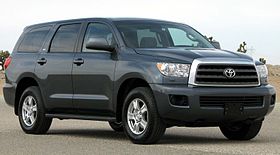Toyota Sequoia
| Toyota Sequoia | |
|---|---|

2008 MY Toyota Sequoia (US)
|
|
| Overview | |
| Manufacturer | Toyota |
| Production | September 2000 – present |
| Model years | 2001–present |
| Assembly | US: Princeton, Indiana (TMMI) |
| Body and chassis | |
| Class | Full-size SUV |
| Body style | 5-door wagon |
| Layout |
Front-engine, rear-wheel-drive Front-engine, four-wheel-drive |
| Related | Toyota Tundra |
| First generation | |
|---|---|
 |
|
| Overview | |
| Production | September 2000 – November 2007 |
| Model years | 2001–2007 |
| Designer | Toshihiko Shirasawa (1997) |
| Powertrain | |
| Engine | |
| Transmission | |
| Dimensions | |
| Wheelbase | 118.1 in (3,000 mm) |
| Length | 203.9 in (5,179 mm) |
| Width |
|
| Height |
|
| Second generation | |
|---|---|
 |
|
| Overview | |
| Production | December 2007 – present |
| Model years | 2008–present |
| Designer | Motoharu Araya |
| Powertrain | |
| Engine | |
| Transmission | |
| Dimensions | |
| Wheelbase | 122.0 in (3,099 mm) |
| Length | 205.1 in (5,210 mm) |
| Width |
|
| Height | 77.0 in (1,956 mm) |
The Toyota Sequoia is a full-size SUV manufactured by Toyota and derived from its Tundra pickup truck.
Introduced in 2000 and manufactured at Toyota Motor Manufacturing Indiana in Princeton, Indiana, the Sequoia is the first vehicle from a Japanese marque in the popular mainstream full-sized SUV class in North America, and initial planning done by first-generation Sequoia chief engineer Kaoru Hosegawa aimed the Sequoia directly at the Ford Expedition, also competing with the Chevrolet Tahoe and the later Nissan Armada.
The Sequoia slots in between the mid-size Toyota 4Runner and the premium Toyota Land Cruiser in the North American Toyota SUV lineup, and is the largest SUV currently being produced under the Toyota brand.
In 2015 the Sequoia was available in the United States (All regions), Bolivia, Canada, Costa Rica, Honduras, Guatemala, Chile, Mexico, Bahrain, Kuwait, Lebanon, Oman, Qatar, Saudi Arabia, the United Arab Emirates, and Yemen in LHD only. As of 2017, the Sequoia is sold in the United States (All regions), Canada, Costa Rica, Mexico, Bahrain, Kuwait, Lebanon, Oman, Qatar, Saudi Arabia, and Yemen in LHD only.
Development of a full-size SUV alongside a T100 replacement began in the mid-1990s, with a design freeze in 1997 (styled by Toshihiko Shirasawa) and design patent filing of the production design on April 4, 1998 at the Japan Patent Office (JPO) under #1054583. After the introduction of the Toyota Tundra in 1999, speculation started that Toyota intended to compete in the full-size market with a Tundra-based SUV called the Highlander. However, the Highlander name was used on a midsize Camry-based crossover and the Tundra-based SUV was introduced on January 11, 2000 at the North American Auto Show as the Toyota Sequoia, with full production starting in September 2000 for the 2001 model year.
The engine, dashboard, sheetmetal, and chassis are shared with the Tundra, with the exception of rear disc brakes and a more sophisticated multi-link live axle rear suspension. The Sequoia was nominated for the North American Truck of the Year award in 2001. When the Sequoia was introduced, it was slightly longer than the contemporary Land Cruiser, larger than the Chevrolet Tahoe in most dimensions and similar in size to the Ford Expedition; its V8 engine was certified as an Ultra Low Emission Vehicle. Frame assemblies and driveshafts are produced by Dana Holding Corporation.
...
Wikipedia
